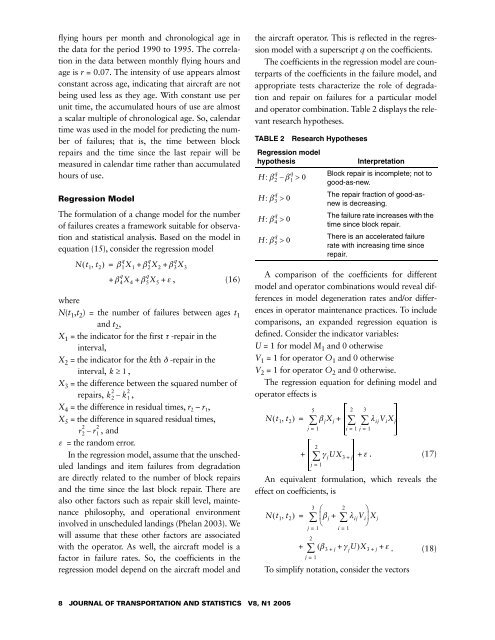journal of transportation and statistics - Research and Innovative ...
journal of transportation and statistics - Research and Innovative ...
journal of transportation and statistics - Research and Innovative ...
Create successful ePaper yourself
Turn your PDF publications into a flip-book with our unique Google optimized e-Paper software.
flying hours per month <strong>and</strong> chronological age inthe data for the period 1990 to 1995. The correlationin the data between monthly flying hours <strong>and</strong>age is r = 0.07. The intensity <strong>of</strong> use appears almostconstant across age, indicating that aircraft are notbeing used less as they age. With constant use perunit time, the accumulated hours <strong>of</strong> use are almosta scalar multiple <strong>of</strong> chronological age. So, calendartime was used in the model for predicting the number<strong>of</strong> failures; that is, the time between blockrepairs <strong>and</strong> the time since the last repair will bemeasured in calendar time rather than accumulatedhours <strong>of</strong> use.Regression ModelThe formulation <strong>of</strong> a change model for the number<strong>of</strong> failures creates a framework suitable for observation<strong>and</strong> statistical analysis. Based on the model inequation (15), consider the regression modelNt ( 1 , t 2 ) = β q 1 X 1 + β q 2 X 2 + β q 3 X 3+ βq 4 X 4 + β q 5 X 5 + ε , (16)whereN(t 1 ,t 2 ) = the number <strong>of</strong> failures between ages t 1<strong>and</strong> t 2 ,X 1 = the indicator for the first τ -repair in theinterval,X 2 = the indicator for the kth δ -repair in theinterval, k ≥ 1 ,X 3 = the difference between the squared number <strong>of</strong>2 2repairs, k 2 – k 1 ,X 4 = the difference in residual times, r 2 – r 1 ,X 5 = the difference in squared residual times,2 2r 2 – r 1 , <strong>and</strong>ε = the r<strong>and</strong>om error.In the regression model, assume that the unscheduledl<strong>and</strong>ings <strong>and</strong> item failures from degradationare directly related to the number <strong>of</strong> block repairs<strong>and</strong> the time since the last block repair. There arealso other factors such as repair skill level, maintenancephilosophy, <strong>and</strong> operational environmentinvolved in unscheduled l<strong>and</strong>ings (Phelan 2003). Wewill assume that these other factors are associatedwith the operator. As well, the aircraft model is afactor in failure rates. So, the coefficients in theregression model depend on the aircraft model <strong>and</strong>the aircraft operator. This is reflected in the regressionmodel with a superscript q on the coefficients.The coefficients in the regression model are counterparts<strong>of</strong> the coefficients in the failure model, <strong>and</strong>appropriate tests characterize the role <strong>of</strong> degradation<strong>and</strong> repair on failures for a particular model<strong>and</strong> operator combination. Table 2 displays the relevantresearch hypotheses.TABLE 2 <strong>Research</strong> HypothesesRegression modelhypothesisqH: β 2 –qH: β 3 > 0qH: β 4 > 0qH: β 5 > 0β 1q> 0InterpretationBlock repair is incomplete; not togood-as-new.The repair fraction <strong>of</strong> good-asnewis decreasing.The failure rate increases with thetime since block repair.There is an accelerated failurerate with increasing time sincerepair.A comparison <strong>of</strong> the coefficients for differentmodel <strong>and</strong> operator combinations would reveal differencesin model degeneration rates <strong>and</strong>/or differencesin operator maintenance practices. To includecomparisons, an exp<strong>and</strong>ed regression equation isdefined. Consider the indicator variables:U = 1 for model M 1 <strong>and</strong> 0 otherwiseV 1 = 1 for operator O 1 <strong>and</strong> 0 otherwiseV 2 = 1 for operator O 2 <strong>and</strong> 0 otherwise.The regression equation for defining model <strong>and</strong>operator effects is5∑Nt ( 1 , t 2 ) = β j X j + λ ij V i X jj = 12∑i = 1 j = 1+ γ j UX 3 + j+ ε . (17)j = 1An equivalent formulation, which reveals theeffect on coefficients, isTo simplify notation, consider the vectors2∑3∑3⎛2Nt ( 1 , t 2 ) = ⎜β j + λ ij V i ⎟+∑j = 1⎝∑i = 12∑ β 3 + j γj = 1⎞Xj( + jU)X 3 j +⎠+ ε. (18)8 JOURNAL OF TRANSPORTATION AND STATISTICS V8, N1 2005
















